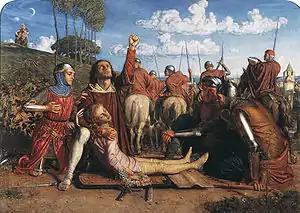Rienzi vowing to obtain justice for the death of his young brother, slain in a skirmish between the Colonna and the Orsini factions
Rienzi vowing to obtain justice for the death of his young brother, slain in a skirmish between the Colonna and the Orsini factions (or simply, Rienzi) is an oil-on-canvas painting by the English artist William Holman Hunt, produced in 1849 and currently in a private collection.
| Rienzi vowing to obtain justice for the death of his young brother, slain in a skirmish between the Colonna and the Orsini factions | |
|---|---|
 | |
| Artist | William Holman Hunt |
| Year | 1849 |
| Medium | oil on canvas |
| Dimensions | 86.3 cm × 122 cm (34.0 in × 48 in) |
| Location | Private collection of Mrs E. M. Clarke |
History
This painting, with its extremely long title, was the first of Hunt's works to include 'PRB' (Pre-Raphaelite Brotherhood) on the canvas.
Hunt took his subject from the 1835 novel Rienzi, the Last of the Roman Tribunes, by Bulwer Lytton,[1] about Cola di Rienzi (1313–1354), a papal notary who led a popular uprising in Rome. It was exhibited at the 1849 Royal Academy exhibition (alongside Millais' Lorenzo and Isabella) with the following excerpt from the novel, describing the hero's reaction to the incident:
But for that event, the future liberator of Rome might have been but a dreamer, a scholar, a poet, - the peaceful rival of Petrarch - a man of thoughts, not deeds. But from that time, all his faculties, energies, fancies, genius, became concentrated to a single point and patriotism, before a vision, leaped into the life and vigour of a passion.
— Rienzi, the Last of the Roman Tribunes, Book I, chap. 1, 23[2]
In 1847, Hunt repeatedly sat up all night to finish John Ruskin's Modern Painters (1843);[3] in Rienzi he attempted to put into practice all that he had read. The background particularly was painted in careful detail trying to satisfy Ruskin's stringent requirements. As can be seen from some of Hunt's later work, such as The Hireling Shepherd (1851) and The Awakening Conscience (1854), the artist often experienced great difficulty with painting his figures in natural poses. This is evident here in the portrayal of the soldier on the far left of the painting.[4]
References
- Several of Bulwer-Lytton's novels were made into operas, with Rienzi, der Letzte der Tribunen being composed by Richard Wagner, and eventually becoming more famous than the novel.
- As quoted by The London Literary Gazette of 5 December 1835, Vol.19 (GoogleBook); see also print ed., Edward George Bulwer-Lytton, Rienzi, the Last of the Roman Tribunes, Adamant Media Corporation (2001). ISBN 0-543-87518-0
- Composed of five volumes, the second one was influential on the early development of Pre-Raphaelitism
- Cf. J. Bronkhurst, William Holman Hunt : A Catalogue Raisonné (2006).
Bibliography
- Landow, George (1979). William Holman Hunt and Typological Symbolism. Yale University Press. ISBN 0-300-02196-8.
- Maas, Jeremy (1984). Holman Hunt and the Light of the World. Ashgate. ISBN 978-0-85967-683-0.
- Bronkhurst, Judith (2006). William Holman Hunt : A Catalogue Raisonné. Yale University Press. ISBN 978-0-300-10235-2.
- Lochnan, Katharine (2008). Holman Hunt and the Pre-Raphaelite Vision. Art Gallery of Toronto. ISBN 978-1-894243-57-5.
External links
- Rienzi in the Rossetti Archive
- Rienzi at VictorianWeb
- Birmingham Museums and Art Gallery's Pre-Raphaelite Online Resource Archived 7 October 2010 at the Wayback Machine Large online collection of about fifty paintings on canvas and works on paper of William Holman Hunt
- William Holman Hunt in the "History of Art" — a paper by Albert Boime published originally in The Art Bulletin 84 no1 94-114 Mr 2002.
- Phryne's list of pictures by Hunt Archived 11 May 2008 at the Wayback Machine
- The Pre-Raph Pack